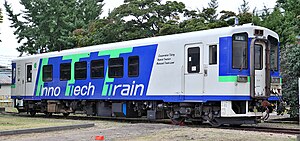KiHa 160
| KiHa 160 | |
|---|---|
 KiHa 160-1 as the "Inno Tech Train", September 2010 | |
| In service | 1997–Present |
| Manufacturer | Niigata Tekkō |
| Constructed | 1997 |
| Refurbished | 2007 |
| Number built | 1 vehicle |
| Number in service | 1 vehicle |
| Formation | Single car |
| Fleet numbers | KiHa 160-1 |
| Capacity | 110 (42 seated) |
| Operators | JR Hokkaido |
| Depots | Tomakomai |
| Specifications | |
| Car body construction | Steel |
| Car length | 18,500 mm (60 ft 8 in) |
| Width | 2,998 mm (9 ft 10.0 in) |
| Height | 4,000 mm (13 ft 1 in) |
| Doors | 2 sliding doors per side |
| Maximum speed | 110 km/h (70 mph)* |
| Weight | 32.5 t |
| Prime mover(s) | 6H13CRE |
| Power output | 330 hp |
| Transmission | Hydraulic |
| Bogies | N-DT150 (motored), N-TR150 (trailer) |
| Multiple working | KiHa 130 |
| Track gauge | 1,067 mm (3 ft 6 in) |
The KiHa 160 (キハ160形) is a single-car diesel multiple unit (DMU) train operated by Hokkaido Railway Company (JR Hokkaido) in Japan. A single car was built in 1997 by Niigata Tekkō (now Niigata Transys) to replace the KiHa 130 DMU car (KiHa 130-5) withdrawn due to collision damage sustained in a level crossing accident in January 1996.[1] The design was based on the Tsugaru Railway 21 series DMU built to Niigata's "NDC" lightweight design.[2] From 2007, the unit was rebuilt as an experimental hybrid car, branded "Inno Tech Train".[2]
History
When delivered, the unit was originally painted in a similar livery to the KiHa 150-0 units, with light green doors, a light green waistline band, and light purple stripes.[3] From September 1999, it was repainted into a new livery similar to the KiHa 40-350 DMUs transferred to the Hidaka Line on which the KiHa 160 was used.[2]
-
KiHa 160-1 in revised livery before rebuilding, at Tomakomai Station
In 2007, the unit was rebuilt as an experimental hybrid vehicle using a motor-assisted hybrid system. At the same time, the longitudinal bench seating was replaced with limited-express style transverse seating.[2]
Following the completion of testing, the unit was placed in storage at Naebo Works.[2]
References
- ^ JR全車輌ハンドブック2009. Japan: Neko Publishing. 2009. p. 473. ISBN 978-4-7770-0836-0.
{{cite book}}: Unknown parameter|trans_title=ignored (|trans-title=suggested) (help) - ^ a b c d e Nishiwaki, Kōji (October 2011). "JR各社の新世代気動車の現状 JR北海道キハ160形 JR東日本キハE200形". Japan Railfan Magazine. Vol. 51, no. 606. Japan: Kōyūsha Co., Ltd. pp. 96–101.
{{cite magazine}}: Unknown parameter|trans_title=ignored (|trans-title=suggested) (help) - ^ JR全車輛ハンドブック1997. Japan: Neko Publishing. 1997. p. 360.
{{cite book}}: Unknown parameter|trans_title=ignored (|trans-title=suggested) (help)
External links
- JR Hokkaido KiHa 160 (Japan Railfan Magazine) Template:Ja icon


